Tale of Four Covers
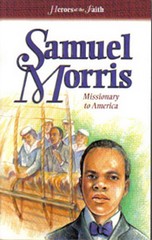
If you haven’t worked inside of a publishing house, it’s likely you haven’t seen the variation of design for a single book cover. In this particular case, these covers are from printed books and different releases. In between th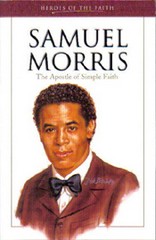 e covers, each book is exactly the same text. It’s a book that I wrote over ten years ago.
e covers, each book is exactly the same text. It’s a book that I wrote over ten years ago.
Samuel Morris was born about 1873 as Kaboo in the interior of Liberia. An African prince, Samuel Morris stole away on a ship coming to America. He became a Christian and actively shared his faith and touched many people during his brief twenty-year life. I was privileged to write the story of his remarkable life. There is a building named in his honor at Taylor University in Upland, Indiana.
The first cover is the first version which was released (on the left). Then the publisher redesigned this Heroes of the Faith series and issued new book covers or this one (on the right).
Then in 1999, the publisher sold part of the rights for this book to Chelsea House Publishers who reaches the educatio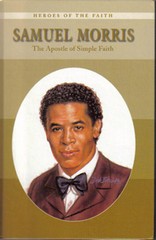 n and library market. Chelsea released a hardcover version of this book as you can see below on the left.
n and library market. Chelsea released a hardcover version of this book as you can see below on the left.
Last week, Barbour Books sent me some copies of the new release of Samuel Morris. The earlier paperback books were in a trade paperback size. This new release (above on the right) is in a mass market size. You can see the sticker which reduces the book to $2.97 but on the back cover the printed price is $4.95. This type of marketing is business as usual for Barbour Books which is known for producing economical books. I was glad to receive this new version of Samuel Morris.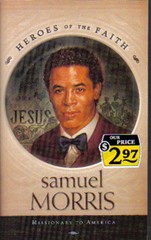
Does anyone notice anything that is missing on the cover of these books? I’ve said it before in these entries about the writing life that one of the hardest things to proofread is something that is not there. Instead of keeping you guessing, I’ll tell you what is missing—the name of the author. It’s not on the cover nor on the spine of the book. It’s another design choice that Barbour Books made with the creation of this series of books. They are content driven—not author driven. A customer doesn’t walk into the store and ask for a book by Terry Whalin and instead they are drawn to the subject matter for the book.
When I signed the contract for this book (and several others that I wrote for Barbour Books), I understood my name would not appear on the cover of the books. It simply wasn’t how the series was designed or marketed and I was OK with it. I did the project as a work made for hire which means you get paid a fee and give up any rights or future earnings or control to the publisher. Thankfully for over ten years, Barbour Books has kept me informed and occasionally sent author copies when the book was changed. They weren’t obligated to send these books but they did it—and that means a lot to an author.
If you are starting out in your writing career, you may wonder why in the world I would write a book without my name on the cover. Or you may be wondering why anyone would do it.
There are many different reasons for writing—and that’s part of my motivation to tell this story. Over ten years ago I had barely published a single book—and that book was a children’s book which released in 1992. I was eager to write additional books—any type of books—whether they included my name on the cover or not. A writing credit is a writing credit and you need to repeat that over and over. My name still appeared on the title page of the book and it counted as a published book. Too many writers only want to write the book if they receive credit. Often you don’t have the luxury of that decision early on in your writing career. Writing work is writing work and you should take it wherever you can find it. While your opportunity might not have everything, an opportunity to write a book is an opportunity—no matter what other details are involved with it (like I had in my experience with this biography).
From my experience in publishing, I know something else about Samuel Morris. It has continued selling at a level which is acceptable for the publish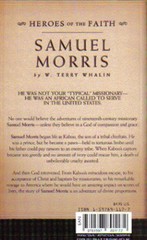 ing executives at Barbour Books. Otherwise why would it continue to be in print? It is selling. Because I wrote this book as a work made for hire, I don’t receive royalty statements (typically where an author can keep track of their sales numbers). In over ten years, I had not even tried to ask for the numbers (and I knew Barbour didn’t have to send them to me). This week, I asked the publisher and to my surprise I learned this book has sold over 74,000 copies! Now it depends on the publisher as to what they call a “bestseller” but in general anything over 5,000 or 10,000 copies is considered good in some circles. From my view, Samuel Morris has done really well.
ing executives at Barbour Books. Otherwise why would it continue to be in print? It is selling. Because I wrote this book as a work made for hire, I don’t receive royalty statements (typically where an author can keep track of their sales numbers). In over ten years, I had not even tried to ask for the numbers (and I knew Barbour didn’t have to send them to me). This week, I asked the publisher and to my surprise I learned this book has sold over 74,000 copies! Now it depends on the publisher as to what they call a “bestseller” but in general anything over 5,000 or 10,000 copies is considered good in some circles. From my view, Samuel Morris has done really well.
With the arrival of the mass market paperback version of Samuel Morris, I received one additional surprise. I know it’s pretty small but check out this back cover (to the left). What I’m trying to point out is the line underneath the book title, Samuel Morris. My name was added to the text. The overall book design is still in the mode of the first version in that the emphasis is not on the author but on the subject matter.
For me, it was a remarkable tale of four covers. I hope it contains some valuable publishing insight for you and your own writing life.





















7 Comment:
Cool post. It is really interesting to see how the covers can/do change over time.
And over 74,000 sold. What an awesome number! :-)
Fascinating as always. I'm glad your name made it to the book cover. Thanks for sharing that.
I always enjoy reading about these sort of things. Thanks for sharing, Terry. And congrats on a bestseller!
Leslie,
My first book was published in 1992--a children's book called When I Grow Up. Since then I've written every other book--now over 60 of them.
As to how I landed the contract when I didn't have much experience? First, I had a great deal of experience writing for magazines so I had a track record in publishing (something many people are missing). Then I connected with the editor of this series about possible projects (another key to the process--talking with lots of different people about their projects). I was also willing to do the work. He offered it and I took it. Like most of this work, it's a matter of finding the right need at the right time and filling it. If you see a successful and on-going series--know that publisher probably plans to expand it--and ask about it. Find out if they are looking for new ideas from you? Or do they have a list of their own ideas and are assigning them? It happens different ways and it will take some questioning from you to discover the path.
Hope that helps,
Terry
The Writing Life
Interesting! And I was looking for your name on the cover. Your explanation was an aha! moment. We've read several from this series--I'll look for this one.
Blessings!
Carmen
I love the last cover, it's great. I'd be proud of those numbers.
I am confused as to how a cover is chosen if it doesn't resemble the photos we have of the person. In this case, anyway, it appears the cover illustration simply does not look like the person we see in the photographs, while the portrait in the original artwork does.
The apparently more handsome man that adorns the cover may have helped sales, I suppose!
I am inspired by the story of his life, regardless. Cheers!
Post a Comment
That's the writing life...
Back to the home page...